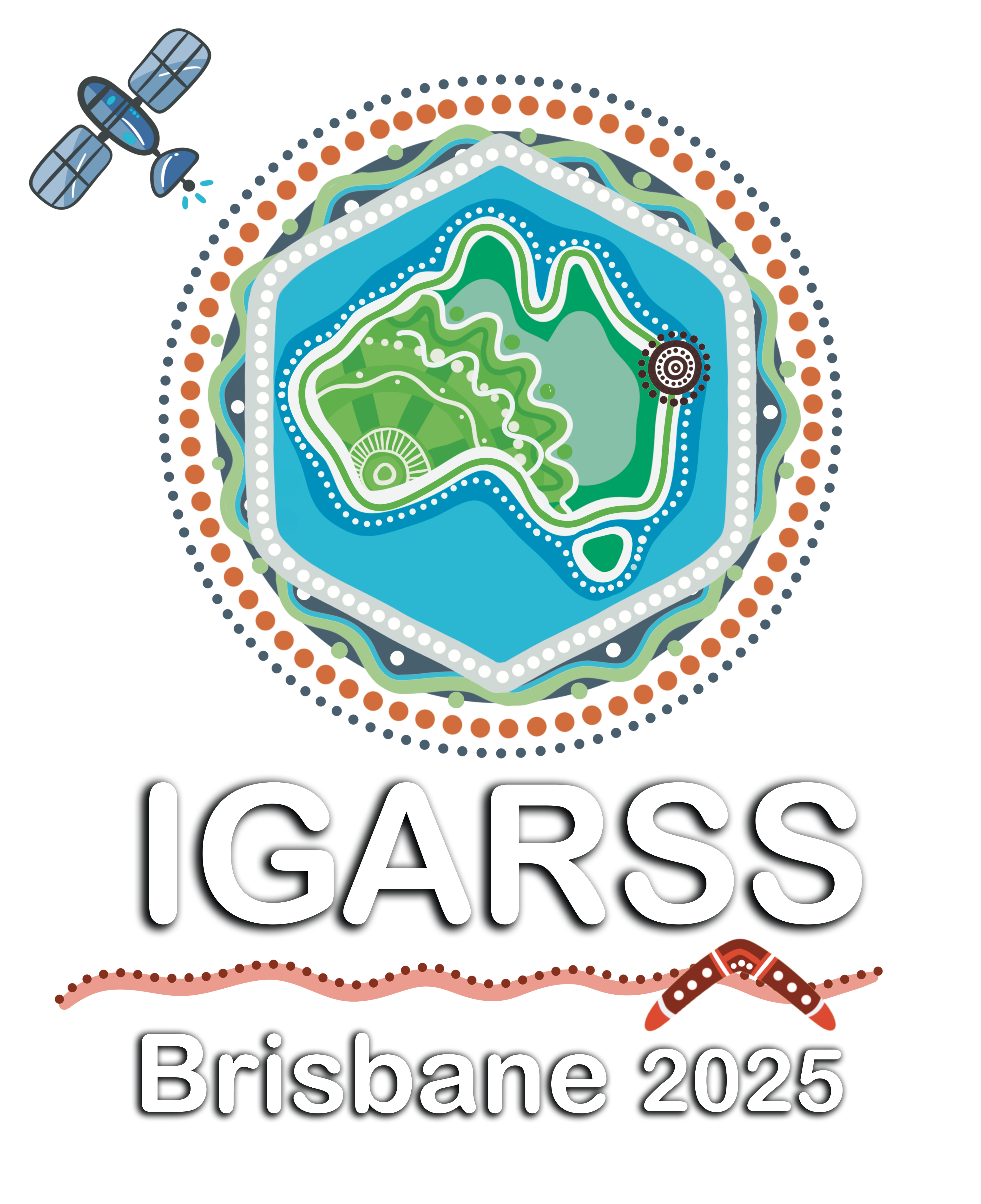The City
Welcome to Meanjin
Queensland’s capital Brisbane (known as Meanjin to the Traditional Custodians of the land),
and Australia’s fastest-growing capital city, is a vibrant hub of innovation and endless
opportunities. Offering an unparalleled blend of cutting-edge research, world-class event
facilities, and a welcoming subtropical climate, Brisbane sets the stage for unforgettable
events. TIME Magazine, Frommers and the New York Times have all named Brisbane one of the
top places in the world to visit. Named host city of the 2032 Olympic and Paralympic Games,
Brisbane continues to shine on the global stage.
Brisbane is a popular tourist
destination. Major landmarks and attractions include South Bank
Parklands, the City Botanic Gardens, King George Square and City Hall, the Story Bridge, the
Mount Coot-tha Botanic gardens and Lookout and the Lone Pine Koala Sanctuary.
The City Botanic Gardens were originally established in 1825 as a farm for the Moreton Bay
penal
settlement and were planted by convicts in 1825 with food crops to feed the prison colony.
In
1855, several acres was declared a Botanic Reserve under Superintendent Walter Hill, a
position
he held until 1881. Some trees planted in the Gardens were among the first of their species
to
be planted in Australia, including the Jacaranda and poinciana.
In the 21st century The Queensland Cultural Centre was expanded, with the completion of the
State Library and the Gallery of Modern Art in 2006, and the Kurilpa Bridge in 2009, the
world’s
largest hybrid tensegrity bridge. Brisbane also hosted major international events including
the
final Goodwill Games in 2001, the Rugby League World Cup final in 2008 and again in 2017, as
well as the 2014 G20 Brisbane summit.
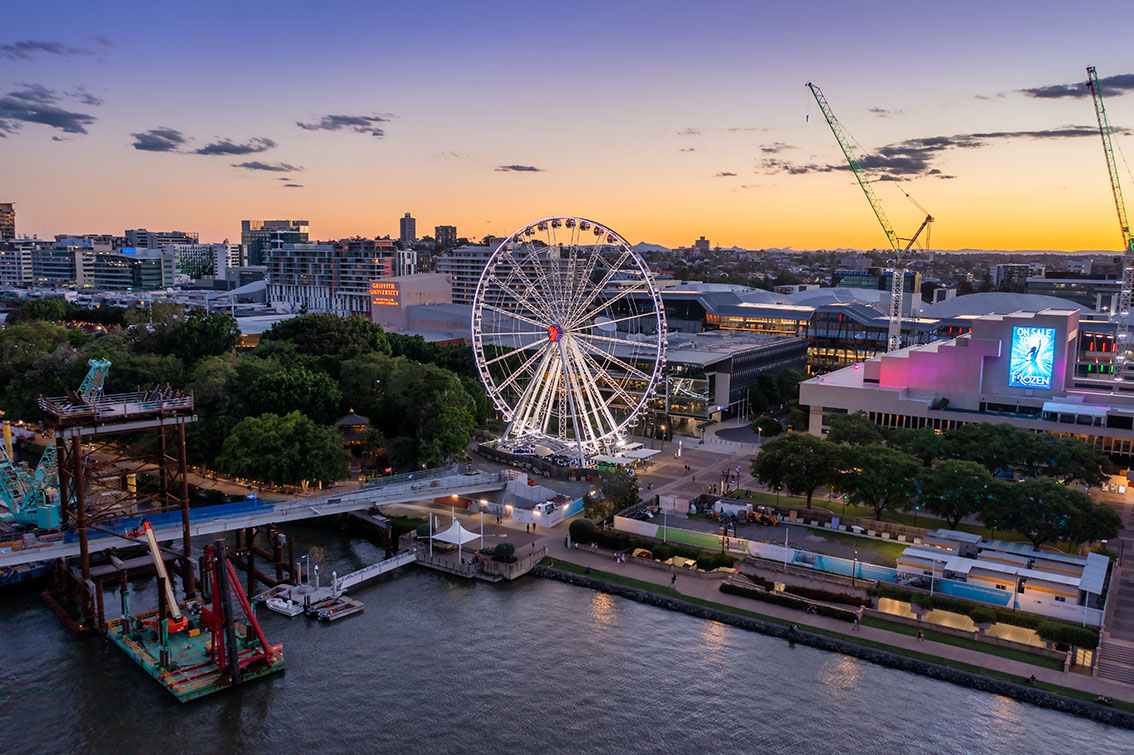
Image: Aerial view of the Brisbane Eye.
Explore Brisbane
Culture
Brisbane is home to several art galleries, the largest of which are the Queensland Art
Gallery
and the Queensland Gallery of Modern Art (GOMA), which is the largest modern art gallery
in
Australia. GOMA holds the Asia Pacific Triennial (APT) which focuses on contemporary art
from
the Asia and Pacific in a variety of media from painting to video work. In addition, its
size
enables the gallery to exhibit particularly large shows.
The Queensland Performing Arts Centre (QPAC) at South Bank, consists of the lyric
theatre,
the
Concert Hall, the Cremorne Theatre, and the Playhouse Theatre and is home to the
Queensland
Ballet, Opera Queensland, the Queensland Theatre Company, and the Queensland Symphony
Orchestra.
Numerous choirs present performances across the city annually. These choirs include the
Brisbane
Chorale, Queensland Choir, Brisbane Chamber Choir, Canticum Chamber Choir, Brisbane
Concert
Choir, Imogen Children’s chorale, and Brisbane Birralee Voices.
For a comprehensive guide to museums, galleries, and unique tours in Brisbane,
check out the following resources:
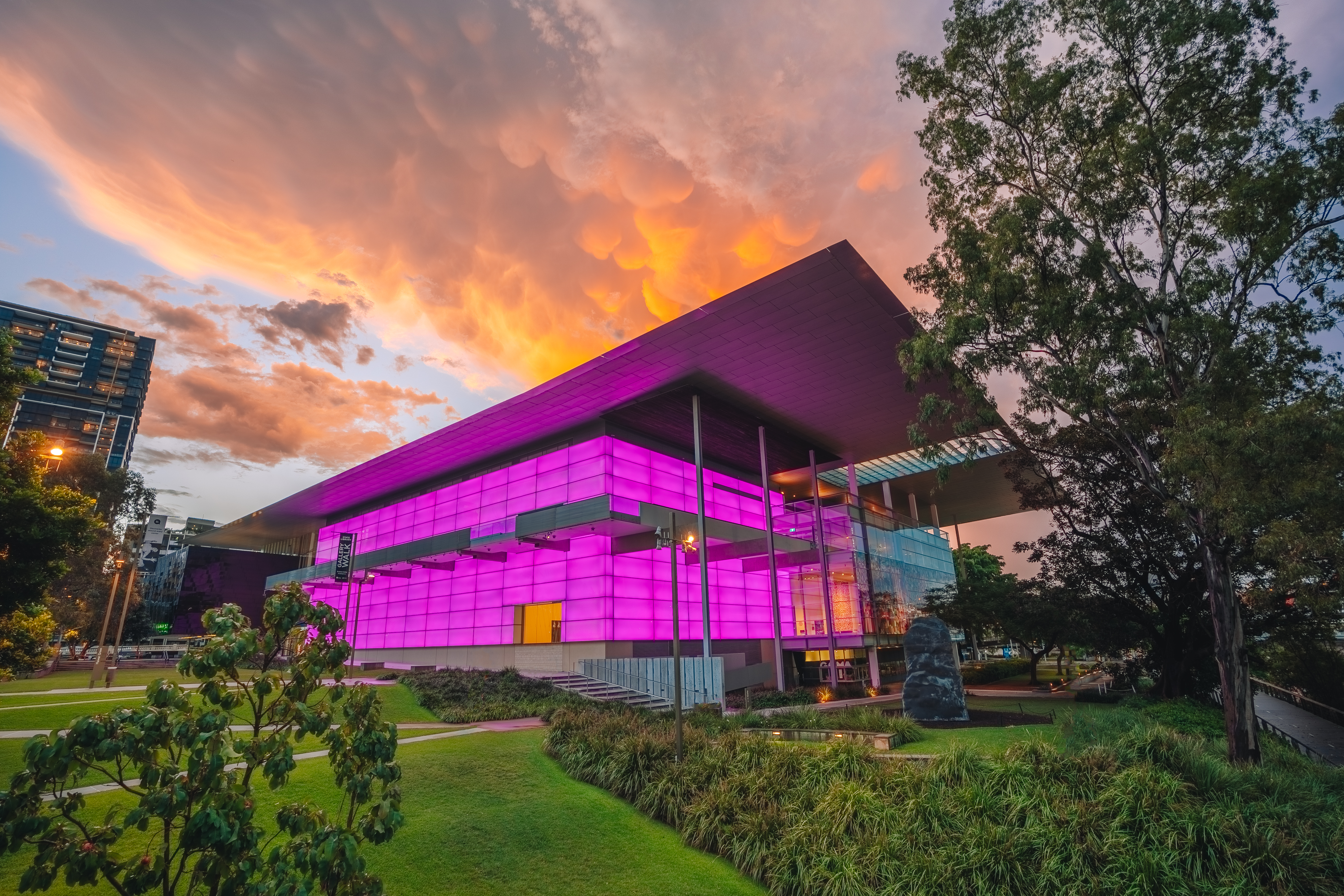
Image: Queensland Gallery of Modern Art
(GOMA)
in
sunset, with lighting up the building.
Demographics
Brisbane’s Greater Capital City Statistical Area includes the Local Government Areas of
City
of
Brisbane, City of Ipswich, City of Moreton Bay, Logan City, and Redland City, as well as
parts
of Lockyer Valley Region, Scenic Rim Region, and Somerset Region, which form a
continuous
metropolitan area. The Australian Bureau of Statistics estimates that the population of
Greater
Brisbane is 2,706,966 as of June 2023, making it the third-largest city in Australia.
The 2021 census showed that 20.7% of Brisbane’s inhabitants were born overseas and 25.2%
of
inhabitants has at least one parent born overseas. Brisbane has the 26th largest
immigrant
population among world metropolitan areas. Of inhabitants born outside of Australia, the
six
most prevalent countries of birth were New Zealand, England, India, Mainland China,
Philippians,
and South Africa.

Image: Lights of Brisbane city and
surrounds
at
dusk
Cuisine
Brisbane's cuisine derives from mainstream Australian culture and many cuisines of
international
origin. Major influences from Asia, Europe, and America reflect the city’s ethnic
diversity,
though Brisbane is represented by a wide range of other ethnic influences.
Brisbane’s culinary scene is often described as more casual with an emphasis on outdoor
dining.
Café culture is prominent, with Australian-style brunch being particularly common.
Roof-top
bars
are also an iconic establishment of the city, as well as its street food scene with food
trucks
and pop-up bars common.
Brisbane is home to over 6,000 restaurants and dining establishments, with outdoor
dining
featuring prominently. Moreton Bay Bugs, less commonly known as flathead lobsters, are
an
ingredient named for the Brisbane region and which feature commonly in the city’s
cuisine.
Some additional foods that are native to Brisbane: Macadamia, Lemon Scented Myrtle,
Australian Finger
Lime,
Bunya Nut, Cinnamon Myrtle, Davidson’s Plum, Riberry, Small-Leaved Tamarind, Midgen
Berry,
and Moreton Bay Rock Oyster.
For those interested in exploring more about where to eat and find exclusive
dining
experiences in Brisbane, check out these articles:
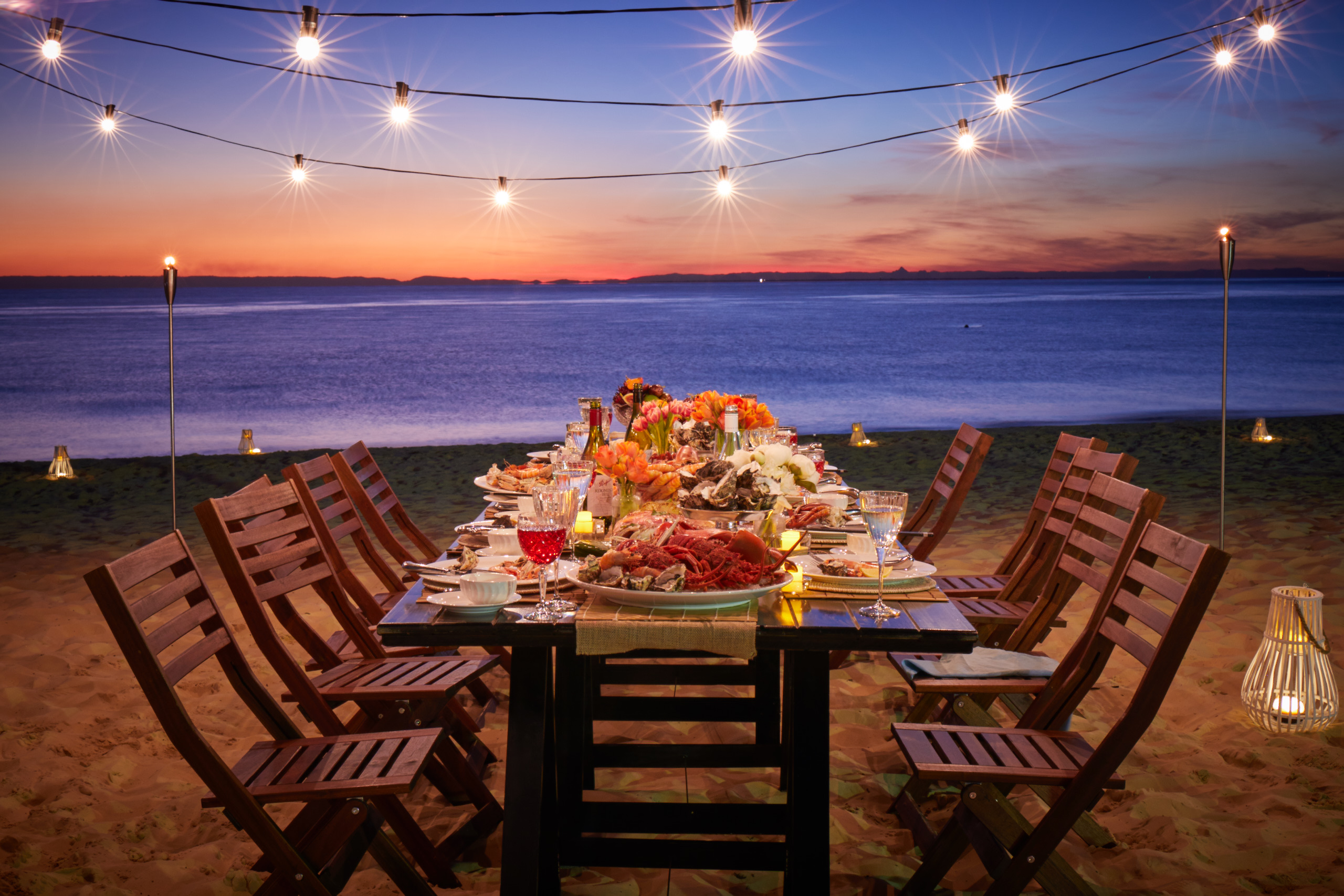
Image: Beach dinner at sunset. Tangalooma,
Brisbane.
Geography
The city of Brisbane is hilly. The urban areas, including the central business district,
are
partially elevated by spurs of the Herbert Taylor Range, such as the summit of Mount
Coot-tha,
reaching up to 300 meters (980 ft) and Enoggera Hill. The D’Aguilar National Park,
encompassing
the D’Aguilar Range, bounds the north-west of Brisbane’s built-up area, and contains the
taller
peaks of Mount Nebo, Camp Mountain, Mount Pleasant, Mount Glorious, Mount Samson and
Mount
Mee.
Other prominent rises in Brisbane are Mount Gravatt, Toohey Mountain, Mount Petrie,
Highgate
Hill, Mount Ommaney, Stephens Mountain, and Whites Hill, which are dotted across the
city.
Brisbane is home to numerous bird species, with common species including rainbow
lorikeets,
kookaburras, galahs, Australian white ibises, Australian brushturkeys, Torresian crows,
Australian magpies, and noisy miners. Common reptiles include common garden skinks,
Australian
water dragons, bearded dragons, and blue-tongued lizards.
With regards to climate, Brisbane has a humid subtropical climate. With hot, wet summers
and
moderately drier, mild winters. Brisbane experiences an annual mean minimum of 16.6 °C
(62
°F)
and a mean maximum of 26.6 °C (80 °F), making it Australia's second-hottest capital city
after
Darwin. Seasonality is not pronounced, and average maximum temperatures of above 26 °C
(79
°F)
persist from October through to April.
In August, Brisbane, Australia enjoys
mild
winter weather, with average temperatures around 16°C. Daily highs typically reach about
21°C, while nighttime lows dip to approximately 11°C. This period also sees relatively
low
rainfall, averaging around 43 mm, making it one of the drier months.
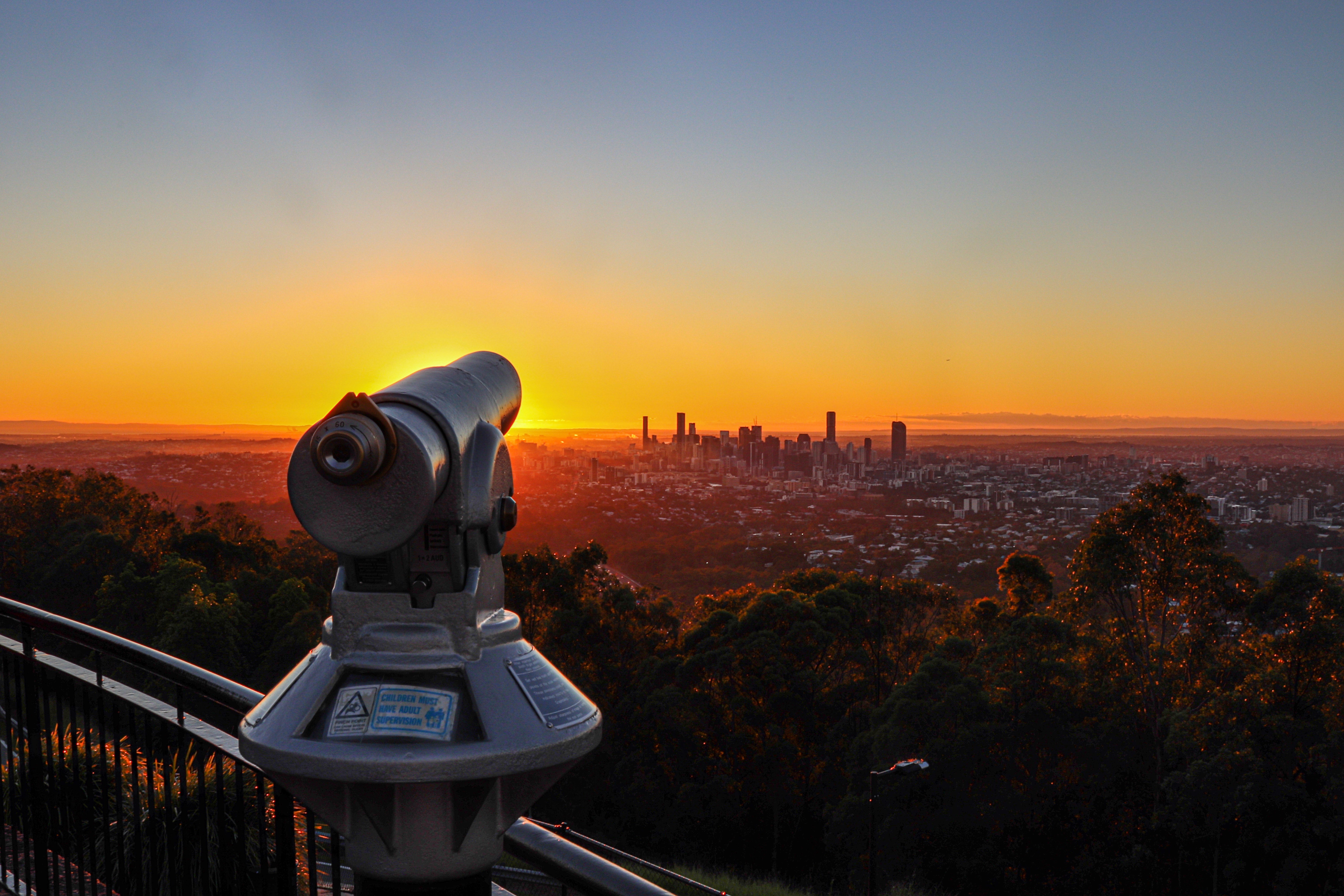
Image: Looking down toward the city from
the
Mount
Coot-tha summit lookout
Welcome to Meanjin
Queensland’s capital Brisbane (known as Meanjin to the Traditional Custodians of the land),
and Australia’s fastest-growing capital city, is a vibrant hub of innovation and endless
opportunities. Offering an unparalleled blend of cutting-edge research, world-class event
facilities, and a welcoming subtropical climate, Brisbane sets the stage for unforgettable
events. TIME Magazine, Frommers and the New York Times have all named Brisbane one of the
top places in the world to visit. Named host city of the 2032 Olympic and Paralympic Games,
Brisbane continues to shine on the global stage.
Brisbane is a popular tourist
destination. Major landmarks and attractions include South Bank
Parklands, the City Botanic Gardens, King George Square and City Hall, the Story Bridge, the
Mount Coot-tha Botanic gardens and Lookout and the Lone Pine Koala Sanctuary.
The City Botanic Gardens were originally established in 1825 as a farm for the Moreton Bay
penal
settlement and were planted by convicts in 1825 with food crops to feed the prison colony.
In
1855, several acres was declared a Botanic Reserve under Superintendent Walter Hill, a
position
he held until 1881. Some trees planted in the Gardens were among the first of their species
to
be planted in Australia, including the Jacaranda and poinciana.
In the 21st century The Queensland Cultural Centre was expanded, with the completion of the
State Library and the Gallery of Modern Art in 2006, and the Kurilpa Bridge in 2009, the
world’s
largest hybrid tensegrity bridge. Brisbane also hosted major international events including
the
final Goodwill Games in 2001, the Rugby League World Cup final in 2008 and again in 2017, as
well as the 2014 G20 Brisbane summit.

Image: Aerial view of the Brisbane Eye.
Explore Brisbane
Culture
Brisbane is home to several art galleries, the largest of which are the Queensland Art Gallery and the Queensland Gallery of Modern Art (GOMA), which is the largest modern art gallery in Australia. GOMA holds the Asia Pacific Triennial (APT) which focuses on contemporary art from the Asia and Pacific in a variety of media from painting to video work. In addition, its size enables the gallery to exhibit particularly large shows.
The Queensland Performing Arts Centre (QPAC) at South Bank, consists of the lyric theatre, the Concert Hall, the Cremorne Theatre, and the Playhouse Theatre and is home to the Queensland Ballet, Opera Queensland, the Queensland Theatre Company, and the Queensland Symphony Orchestra. Numerous choirs present performances across the city annually. These choirs include the Brisbane Chorale, Queensland Choir, Brisbane Chamber Choir, Canticum Chamber Choir, Brisbane Concert Choir, Imogen Children’s chorale, and Brisbane Birralee Voices.
For a comprehensive guide to museums, galleries, and unique tours in Brisbane, check out the following resources:

Image: Queensland Gallery of Modern Art (GOMA) in sunset, with lighting up the building.
Demographics
Brisbane’s Greater Capital City Statistical Area includes the Local Government Areas of
City
of
Brisbane, City of Ipswich, City of Moreton Bay, Logan City, and Redland City, as well as
parts
of Lockyer Valley Region, Scenic Rim Region, and Somerset Region, which form a
continuous
metropolitan area. The Australian Bureau of Statistics estimates that the population of
Greater
Brisbane is 2,706,966 as of June 2023, making it the third-largest city in Australia.
The 2021 census showed that 20.7% of Brisbane’s inhabitants were born overseas and 25.2%
of
inhabitants has at least one parent born overseas. Brisbane has the 26th largest
immigrant
population among world metropolitan areas. Of inhabitants born outside of Australia, the
six
most prevalent countries of birth were New Zealand, England, India, Mainland China,
Philippians,
and South Africa.

Image: Lights of Brisbane city and surrounds at dusk
Cuisine
Brisbane's cuisine derives from mainstream Australian culture and many cuisines of
international
origin. Major influences from Asia, Europe, and America reflect the city’s ethnic
diversity,
though Brisbane is represented by a wide range of other ethnic influences.
Brisbane’s culinary scene is often described as more casual with an emphasis on outdoor
dining.
Café culture is prominent, with Australian-style brunch being particularly common.
Roof-top
bars
are also an iconic establishment of the city, as well as its street food scene with food
trucks
and pop-up bars common.
Brisbane is home to over 6,000 restaurants and dining establishments, with outdoor
dining
featuring prominently. Moreton Bay Bugs, less commonly known as flathead lobsters, are
an
ingredient named for the Brisbane region and which feature commonly in the city’s
cuisine.
Some additional foods that are native to Brisbane: Macadamia, Lemon Scented Myrtle,
Australian Finger
Lime,
Bunya Nut, Cinnamon Myrtle, Davidson’s Plum, Riberry, Small-Leaved Tamarind, Midgen
Berry,
and Moreton Bay Rock Oyster.
For those interested in exploring more about where to eat and find exclusive dining experiences in Brisbane, check out these articles:

Image: Beach dinner at sunset. Tangalooma, Brisbane.
Geography
The city of Brisbane is hilly. The urban areas, including the central business district,
are
partially elevated by spurs of the Herbert Taylor Range, such as the summit of Mount
Coot-tha,
reaching up to 300 meters (980 ft) and Enoggera Hill. The D’Aguilar National Park,
encompassing
the D’Aguilar Range, bounds the north-west of Brisbane’s built-up area, and contains the
taller
peaks of Mount Nebo, Camp Mountain, Mount Pleasant, Mount Glorious, Mount Samson and
Mount
Mee.
Other prominent rises in Brisbane are Mount Gravatt, Toohey Mountain, Mount Petrie,
Highgate
Hill, Mount Ommaney, Stephens Mountain, and Whites Hill, which are dotted across the
city.
Brisbane is home to numerous bird species, with common species including rainbow
lorikeets,
kookaburras, galahs, Australian white ibises, Australian brushturkeys, Torresian crows,
Australian magpies, and noisy miners. Common reptiles include common garden skinks,
Australian
water dragons, bearded dragons, and blue-tongued lizards.
With regards to climate, Brisbane has a humid subtropical climate. With hot, wet summers
and
moderately drier, mild winters. Brisbane experiences an annual mean minimum of 16.6 °C
(62
°F)
and a mean maximum of 26.6 °C (80 °F), making it Australia's second-hottest capital city
after
Darwin. Seasonality is not pronounced, and average maximum temperatures of above 26 °C
(79
°F)
persist from October through to April.
In August, Brisbane, Australia enjoys
mild
winter weather, with average temperatures around 16°C. Daily highs typically reach about
21°C, while nighttime lows dip to approximately 11°C. This period also sees relatively
low
rainfall, averaging around 43 mm, making it one of the drier months.

Image: Looking down toward the city from the Mount Coot-tha summit lookout
